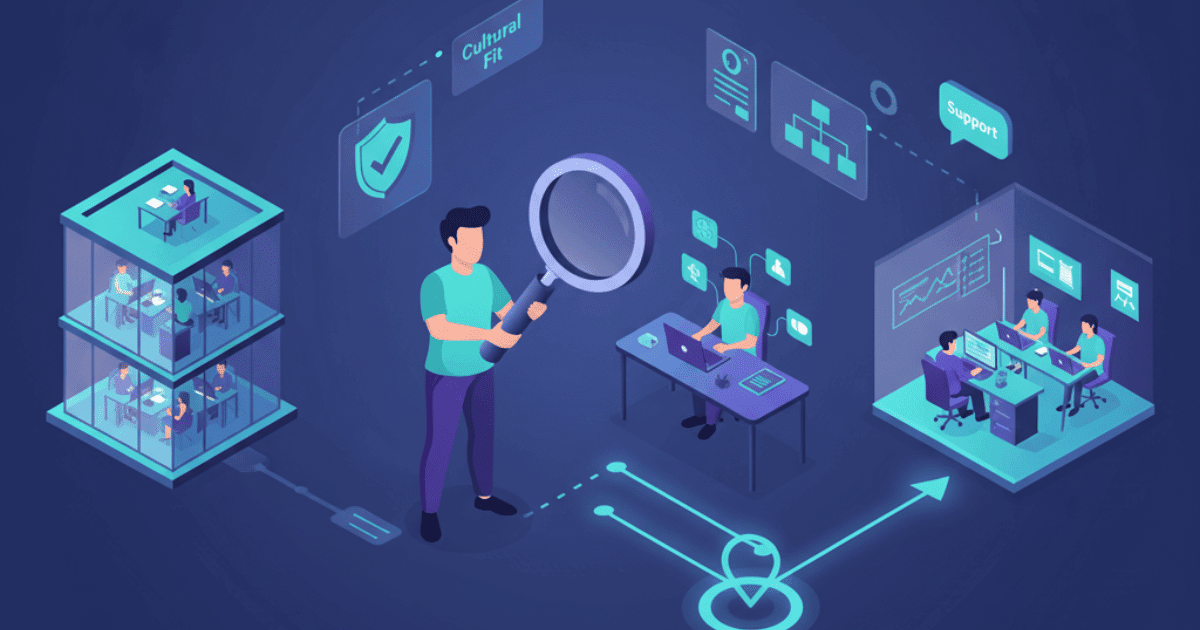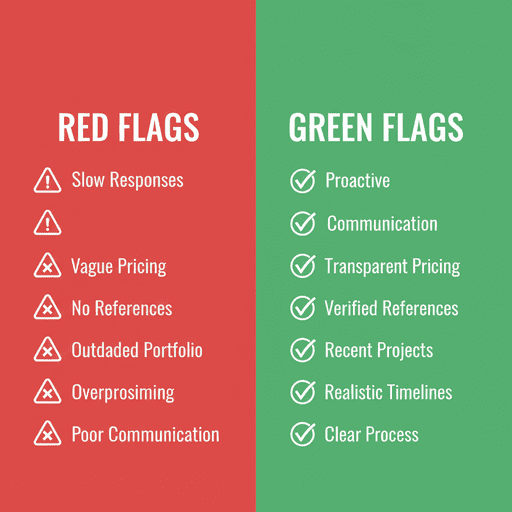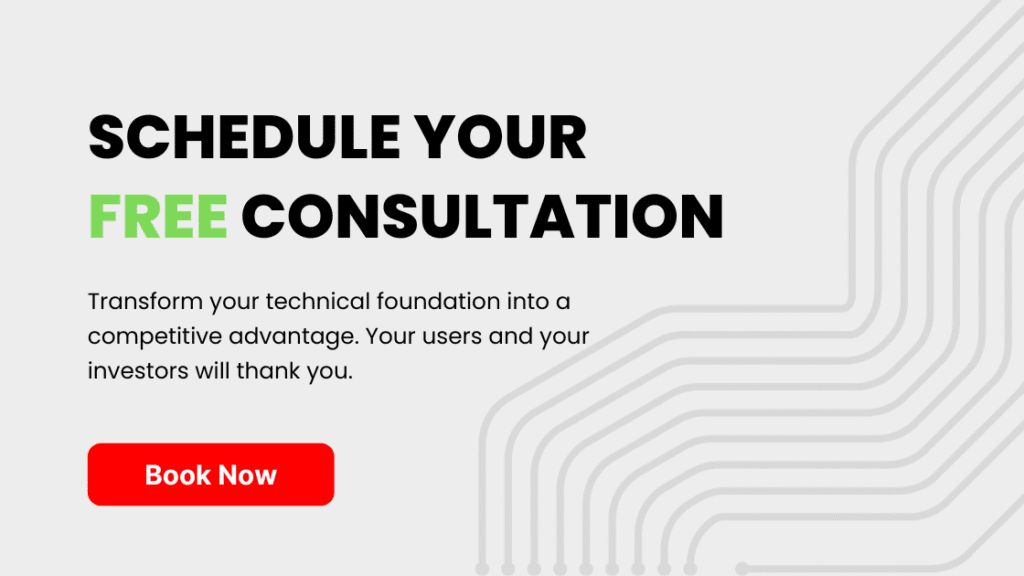Key Takeaways
- Cultural alignment predicts success more than technical skills—
of failed outsourcing relationships stem from misaligned values and communication breakdowns.
- Portfolio depth matters more than breadth—agencies with 5-10 projects in your industry deliver
faster than generalists.
- Process transparency is non-negotiable—clear roadmaps, defined communication channels, and agile methodologies prevent
of common project failures.
- Real client relationships reveal truth—go beyond testimonials to speak with 3-5 past clients about actual working experiences.
- Budget
contingency for scope changes—even well-planned projects encounter unforeseen requirements.
- Contract structure impacts outcomes—fixed-price creates rigidity, time-and-materials enables flexibility, hybrid models balance both.
- Post-launch support is critical—
of development companies don’t offer adequate maintenance, leaving startups vulnerable.

Introduction: Why Hiring the Right Development Partner Changes Everything
Understanding how to hire a software company ranks among the most consequential decisions startup founders make. According to Standish Group research, only of software projects succeed as planned, with
experiencing cost overruns or delays. The difference between success and failure often comes down to partner selection, not technical complexity.
The stakes are substantial. The wrong development partner doesn’t just delay your launch—it creates technical debt that compounds over months, drains your runway faster than planned, and can ultimately destroy product-market fit timing. Conversely, the right partner becomes an extension of your team, accelerating development, providing strategic guidance, and helping you navigate the countless decisions that determine product success. The core challenge is learning how to hire a software company that truly aligns with your long-term vision.
This comprehensive guide reveals the exact framework successful founders use when learning how to hire a software company—from assessing cultural alignment to evaluating technical capabilities, validating claims, negotiating contracts, and ensuring long-term partnership success. Whether you’re building your first MVP or scaling an existing product, this roadmap helps you make confident decisions that maximize your chances of success. Hiring a software company is a decision that demands this level of detail.
Step 1: Assess Cultural Alignment and Vision Fit
Before evaluating technical capabilities, assess whether the development company shares your vision and values. According to Harvard Business Review research, cultural misalignment causes of partnership failures—more than technical inadequacy.
The Human Element Test
Great development partners act like co-founders, not vendors. They challenge your assumptions, invest emotionally in your success, and proactively identify problems before they escalate.
Evaluation Questions During Initial Conversations:
- Do they ask “why” before discussing “how”?
- Are they genuinely curious about your market and users?
- Do they challenge your assumptions constructively?
- Can they articulate your value proposition back to you?
- Do they seem excited about the opportunity or just another project?
Red Flags:
- ❌ Immediate agreement with everything you say.
- ❌ Focus solely on technical specifications without business context.
- ❌ Generic questions that could apply to any project.
- ❌ Pushing their preferred solutions before understanding your needs.
- ❌ Transactional communication style focused on contracts and payments.
Green Flags:
- ✅ Thoughtful questions about your target users and their problems.
- ✅ Constructive challenges to your approach with alternatives.
- ✅ Stories about how they’ve helped other founders succeed.
- ✅ Genuine enthusiasm when discussing your vision.
- ✅ Collaborative problem-solving mindset.
Communication and Transparency
Effective partnerships require clear, frequent communication. Evaluate communication style during the vetting process—it won’t improve after contracts are signed.
Assessment Criteria:
- Responsiveness: How quickly do they respond to inquiries? (Target: within 24 hours). Do they proactively update you or wait for you to ask?
- Clarity: Can they explain technical concepts in plain language? Do they provide clear documentation and summaries?
- Honesty: Do they admit when they don’t know something? Are they upfront about limitations and risks?
Values Alignment Assessment
Beyond communication, assess whether their core values match yours. Misaligned values create friction that compounds over time.
Key Value Dimensions:
- Quality vs. Speed: Do they prioritize shipping fast or building right? What’s their approach to technical debt?
- Transparency vs. Opacity: Do they share challenges openly or hide problems? Are their processes and decisions visible to you?
If you’re looking for a development partner that prioritizes cultural alignment and collaborative partnership, explore our team subscription services designed specifically for startups needing flexible, integrated development support. Choosing a software company based on values is paramount.
Step 2: Evaluate Portfolio and Relevant Experience
Past performance predicts future results. A development company’s portfolio reveals their capabilities, specialization, and the quality of work they actually deliver.
Industry Experience Assessment
According to McKinsey research, companies with relevant industry experience complete projects faster and with
fewer defects than generalists.
Industry Experience Evaluation:
- Depth Over Breadth: Look for 10-15 projects in your specific industry (fintech, healthtech, e-commerce) rather than a few projects across multiple sectors. Avoid generalists with no projects in your field.
- Relevant Complexity: Have they built similar technical features (payment processing, real-time chat, AI/ML integration)? Do they understand your regulatory requirements (HIPAA, GDPR, PCI-DSS)?
- Success Indicators: Look beyond “we built this app” to actual, measurable outcomes. Did the product successfully launch and gain users? Has the startup raised funding post-launch?
Verification Methods: You must go beyond the portfolio page when you hire a software company.
- Check Crunchbase: Search for portfolio companies, verify funding rounds and growth trajectory, and confirm the company is still operational.
- Visit Portfolio Products: Actually use the applications they built. Assess user experience and performance, and evaluate current functionality and maintenance.
- Research on Product Hunt: See launch performance and community reception, read user feedback and discussions, and assess the product’s evolution over time.
Technical Capabilities Validation
Beyond portfolio reviews, validate specific technical capabilities relevant to your project. This is a critical step in deciding who to hire as a software company.
Validation Approach:
Ask specific technical questions about your requirements: “How would you architect a real-time notification system that scales to 100K concurrent users?” Evaluate their answers for:
- ✅ Specific, detailed responses with trade-off discussions.
- ✅ Multiple solution options with pros/cons.
- ✅ Real-world examples from past projects.

Step 3: Examine Technology Stack and Approach
The technology choices a development company makes impact your product’s long-term scalability, maintainability, and cost. Understanding how to choose a software company requires evaluating their technology philosophy.
Technology Stack Assessment
Evaluate whether they use modern, well-supported technologies or outdated stacks that will create long-term maintenance challenges.
- Modern Stacks (2025): React 18+, Next.js 14+, Node.js, Python (FastAPI/Django), PostgreSQL, AWS/Google Cloud with infrastructure-as-code.
- Outdated Stacks (Avoid): Legacy frameworks without active maintenance, proprietary platforms with vendor lock-in, monolithic architectures without microservice options.
Technology Selection Philosophy
More important than their current stack is their approach to technology selection. Do they recommend technologies based on your needs or their preferences?
Green Flag Approach: They discuss trade-offs, ask about your future scalability plans, consider your team’s existing skills, and prioritize open-source tools.
Red Flag Approach: They only build with one specific technology, cannot explain the recommendation rationale, or push proprietary/obscure technologies.
For expert guidance on technology stack selection and architectural decisions when you hire a software company, schedule a consultation to discuss your specific requirements and receive tailored recommendations.
Step 4: Understand Their Development Process
A company’s development process determines project success more than their technical skills. Clear processes create predictability, transparency, and accountability.
Methodology and Framework
Most successful development companies use Agile methodologies (Scrum or Kanban) that enable iterative development and continuous feedback.
Key Agile Principles:
- Sprints: 1-2 week development cycles with clear deliverables.
- Daily Standups: Brief team syncs on progress and blockers.
- Sprint Reviews: Demo completed work and gather feedback.
Ask: “Walk me through your typical development process from project kickoff to launch.”
Communication and Reporting Structure
Request examples of their standard reporting. You need visibility into:
- Sprint progress reports (with burndown charts).
- Budget and timeline updates.
- Risk and blocker identification.
Timeline and Milestone Planning
Experienced development companies provide detailed timelines with clear assumptions and contingencies.
- Comprehensive Timeline Should Include: Discovery (1-2 weeks), Design (2-4 weeks), Development Sprints (6-16 weeks), Testing & QA (ongoing + final 1-2 weeks), Deployment, and Handoff.
- Buffer and Contingency: Add
buffer for unforeseen requirements.
Warning Signs: Timelines that seem too fast (e.g., promises MVP in 4-6 weeks) or no buffer/contingency planning.
Quality Assurance Practices
Ask: “What’s your testing strategy and how do you ensure code quality?” Look for:
- Automated Testing: Unit tests, integration tests, end-to-end tests.
- Manual Testing: Exploratory testing and User Acceptance Testing (UAT).
- Code Quality: Code reviews by senior developers and technical debt tracking.
Step 5: Validate Claims and Check References
Portfolio pages and sales pitches paint ideal pictures. Validation reveals reality. Learning how to hire a software company requires going beyond marketing materials.
Client Reference Checks
Request contact information for 3-5 recent clients. Ask questions about execution, communication, and whether they would work with them again.
Third-Party Review Platforms
Check independent review sites like Clutch and GoodFirms for unfiltered feedback.
Warning: Be aware that some companies purchase fake reviews. Cross-reference platform reviews with direct client conversations and verifiable public case studies.
Technical Due Diligence
If possible, involve your technical advisors or CTO. This includes reviewing sample code, conducting technical interviews, and checking their security practices.
Step 6: Understand Pricing Models and Contract Structure
Pricing structure significantly impacts project outcomes. Different models suit different project types and risk tolerances.
Pricing Model Comparison
| Model | Best For | Advantages | Disadvantages |
| Fixed-Price | Well-defined projects | Predictable costs, budget certainty | Inflexible to scope changes, higher initial estimates |
| Time-and-Materials (T&M) | Evolving products, uncertain scope | Maximum flexibility for changes | Budget uncertainty, requires more client oversight |
Most startups benefit from T&M or hybrid models for initial MVP development, as the scope almost always evolves.
Contract Essentials
Critical contract clauses to include when you hire a software company:
- Intellectual Property: You must own all code, designs, and deliverables (Work-for-Hire Clause).
- Payment Terms: Milestone-based payments.
- Post-Launch Support: Guaranteed bug fix period (e.g., 30-90 days) and ongoing maintenance options.
For help structuring contracts and engagement models that protect your interests while enabling successful collaboration, explore our flexible team subscription options designed specifically for startup needs.
Step 7: Assess Post-Launch Support and Maintenance
Software requires ongoing maintenance consuming of initial development costs annually. Many development companies excel at building but fail at supporting.
Essential Support Services
- Bug Fixes and Issues: Guaranteed response times (4-hour for critical).
- Performance Monitoring: Server uptime and application performance monitoring (APM).
- Updates and Patches: Security updates and framework upgrades.
Knowledge Transfer and Documentation
Demand comprehensive documentation to prevent vendor lock-in. This includes architecture diagrams, API documentation, and well-commented code.
Step 8: Red Flags and Warning Signs to Avoid

Recognizing warning signs early prevents costly mistakes. Proceed with extreme caution if you see 2-3 of these; walk away if you see 4+.
|
Category |
Red Flags |
|---|---|
|
Communication |
❌ Slow/inconsistent responses; Pressure tactics; Overpromising unrealistic timelines; Unclear pricing. |
|
Technical |
❌ Outdated portfolio; Generic, one-size-fits-all solutions; No testing strategy; Resistance to discussing security or scalability. |
|
Business/Legal |
❌ No verifiable references; High employee turnover; Demands |
|
Relationship |
❌ Not asking questions (Yes-Man Syndrome); Missing chemistry; No strategic input beyond execution. |
Conclusion: Making Your Final Decision
Mastering how to hire a software company determines whether your product launches successfully or becomes another cautionary tale.
The framework is comprehensive but essential: Assess cultural alignment first. Validate their experience. Evaluate their process for transparency. Finally, structure the contract and pricing model to align incentives and protect your IP.
A successful partnership is an investment, not a cost. Choose a partner, not a vendor, and you will dramatically maximize your startup’s chance of success. Hiring a software company is the first step toward building your vision.
Frequently Asked Questions
How much does it cost to hire a software company?
Costs vary dramatically based on location, complexity, and engagement model. For a typical startup MVP, expect $50,000–$150,000 for 3-6 months of development. When planning to hire a software company, budget realistically and include contingency for unexpected requirements.
Should I hire local or offshore development companies?
- Local: Offers same-timezone communication but costs 2-4x more.
- Offshore: Provides cost savings but faces time zone and potential communication barriers.
Prioritize communication quality and cultural fit over pure cost savings when you hire a software company.
How long should the development process take?
Typical MVP development timeline is 4-6 months from kickoff to launch. Beware of companies promising MVPs in 6-8 weeks unless the scope is extremely limited.
What’s the difference between fixed-price and time-and-materials contracts?
- Fixed-Price: Suitable for well-defined scope; provides budget certainty but limits flexibility.
- Time-and-Materials (T&M): Charges for actual hours worked; provides maximum flexibility for iteration but requires more client oversight.
How do I protect my intellectual property with outsourced development?
Include a Work-for-Hire Clause stating you own all code, an IP Assignment clause, a robust NDA, and request code repository access from day one.
What questions should I ask during the initial consultation?
Ask about their process, similar experience in your industry, realistic timeline, foreseen challenges, and post-launch support. The best companies ask as many questions as they answer. These questions help you hire a software company that truly understands your needs.

Need expert guidance on selecting the right development partner? Explore our team subscription services designed specifically for startups needing flexible, collaborative development support—or schedule a consultation to discuss your specific requirements and receive personalized recommendations when you’re ready to hire a software development company.
Your product’s success starts with one great partnership decision. Make it count.
